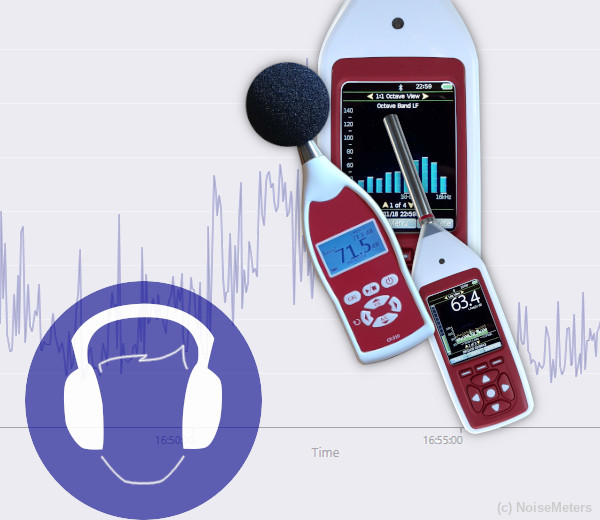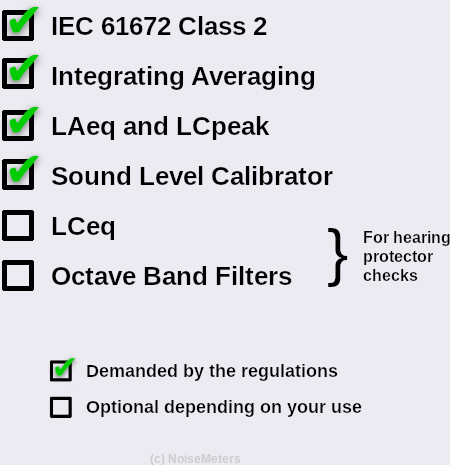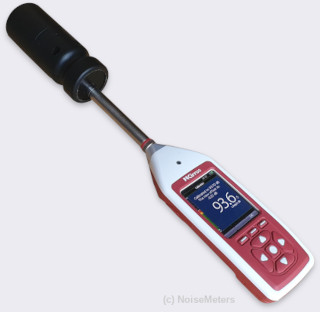With so many different makes and models of sound level meter available, it can be difficult to choose the best model for your noise at work risk assessment. Selecting a meter that doesn't meet the requirements of the regulations or local guidelines renders your noise measurements useless and puts people at risk of hearing damage.
This article uses standard terms to specify the type of meter you should use. Where it talks about a Class 2 Integrating Sound Level Meter for example, that is a requirement of the regulations, not invented by NoiseMeters.
For the regular user a high specification meter is worth the extra cost and learning effort as the meter will be used regularly. Many of those extra features will ultimately make life easier. The higher spec meter will also open up more markets for a noise consultant. For almost everybody else a sound level meter will be used for a full noise assessment once or twice each year and for additional checks when anything changes the acoustic environment, such as new machinery or machinery relocation.
If you search online for "noise at work sound level meter" or anything similar you will see plenty of low-cost meters that claim to be suitable. Some may claim to be Class 2, but even if they manage to actually meet the standards to Class 2 they are still not Integrating meters, as required by the regulations.
You are unlikely to find a suitable Class 2 Integrating Sound Level Meter with Calibrator (also required by the regulations) for less than £700 +VAT.
The HSE are clear about the fact that noise control should be carried out by a "Competent Person". If you buy the wrong meter then you can't blame your supplier. The argument is that it is your responsibility to understand what the regulations demand and if you can't choose the right meter then how can you be a competent person? This article is to help you to identify the correct meter for your noise at work assessment.

The regulations don't demand anything regarding memory, data storage or any automatic calculations. Those things can be useful and will be discussed later but they are not part of the requirements. A standard Class 2 Integrating Sound Level Meter and Calibrator will do the job.
So when shopping online or digging through our catalog, here are the specifications you are looking for:
If you have high noise levels and provide hearing protection then you need to be sure that the hearing protection reduces the noise to a safe sound level. You also need to avoid over protecting.
For you to assess hearing protectors the sound level meter needs to measure the LCeq (C weighted average sound level) or carry out Octave Band Analysis. Most integrating sound level meters will provide LCeq too, but you should check. The HSE guidelines suggest that Octave Band Analysis is only beneficial for noise with a tonal content. If you have high noise levels, provide hearing protection and have tonal noise then we recommend a meter with octave band filters.
Acoustic terms can be a little strange, so here are the more common mistakes.
Should I Measure LEP,d? - LEP,d is the daily noise exposure level and it is calculated, not measured. The EU regulations refer to it as LEX,8h and the UK guidelines call it LEP,d but it is the same thing. You measure the LAeq using the meter and then calculate a worker's daily exposure or LEP,d.
Max Sound Level or Impulse Instead of Peak?
Maximum Sound Level and Impulse Sound Level are not the same as Peak. They are very different parameters and will give very different results. You cannot use Max or Impulse instead of Peak.

A new sound level meter that meets IEC 61672 will be provided with a calibration certificate when new. It shows the meter has been through the tests defined by that standard along with the date that the tests were carried out and details of the laboratory where the tests were done. These tests are very detailed and carried out at many different levels and frequencies.
To satisfy the regulations and guidelines this type of calibration should be carried out at least once every two years.
In addition to this you need a Sound Level Calibrator. This is a small device that fits on the microphone and emits a very precise tone. It is used to check the basic function of the sound level meter before and after making measurements.
The ability to download the measurements is not a requirement of the regulations or HSE guidelines. In fact, for the occasional small noise assessment the process of downloading and generating reports will probably take longer than just writing the results in a word processor.
Having said that, if your budget stretches to it or if you are making regular surveys, software that deals with the long-term storage of results and produces noise reports can make life much easier.
Another consideration is the calculation of LEP,d - daily noise exposure. If you have workers moving around between different noisy areas the calculation of LEP,d can be time consuming. Downloading the measurements and running them through LEP,d calculators makes this easier.

Everything we have covered so far will help you to select the correct sound level meter made by any reputable manufacturer.
From this point on we discuss the sound level meters offered by NoiseMeters that fully meet the requirements of the noise at work regulations and the guidelines offered by the HSE.
While we have a huge range of sound level meters we limit our recommendation to three meters. The order codes here are for what we refer to as "noise measurement kits". They include a suitable sound level meter and calibrator as required.


The CK310 Noise Measurement Kit includes a Cirrus CR310 Integrating Sound Level Meter, and Cirrus CR514 Calibrator. Both are provided with calibration certificates and both meet the requirements of the EU noise at work regulations and HSE guidelines. This is our lowest cost option for a noise at work risk assessment.

This meter adds the ability to store measurements and download them to a computer. Software is included to produce noise at work assessment reports and to assist in keeping long-term records. The meter can be upgraded at a later to date to have octave band filters should that become necessary.

With octave band filters this meter can be used to carry out a more detailed analysis of the available hearing protectors. Ideal when the noise levels are very high and with a tonal content. This meter covers everything, from quick surveys with no logging to full assessment and octave band analysis.